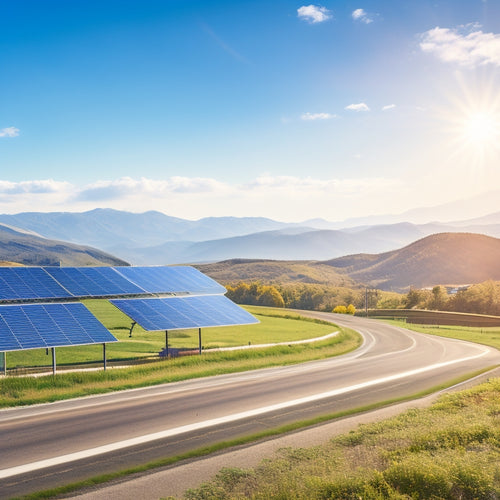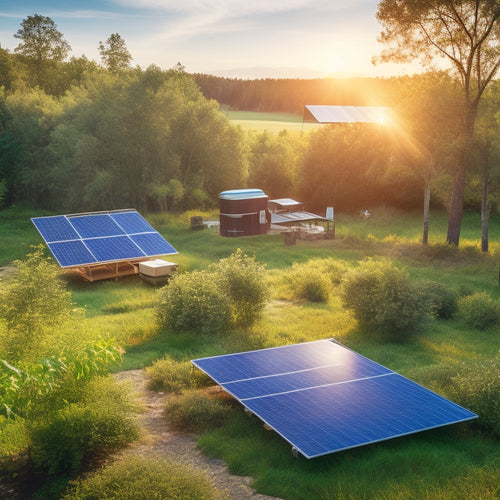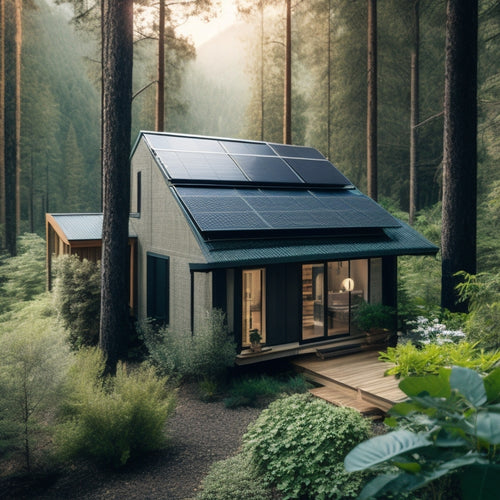
Solar Panel Mounting System
Share
As you evaluate solar panel mounting systems, you're likely looking for one that optimizes energy harvesting, guarantees structural integrity, and withstands environmental factors. A well-designed system should maximize roof space efficiency, allow for adjustable tilt angles to capture peak sunlight, and consider load capacity ratings to prevent failures. Additionally, wind load management is vital, and a secure roof attachment and aerodynamic design can reduce wind load risks. By prioritizing these factors, you'll be well on your way to finding a reliable and efficient solar panel mounting system that meets your unique needs - and there's more to investigate to guarantee you make an informed decision.
The Essentials
- Adjustable tilt angles and seasonal adjustments optimize energy harvesting throughout the year, maximizing energy production during peak sun hours.
- Load capacity ratings and structural integrity factors ensure the mounting system can withstand environmental conditions, weight distribution, and snow loads.
- Customized installation options cater to specific roof layouts, obstructions, and aesthetic preferences, enhancing overall system effectiveness and energy output.
- Corrosion-resistant materials and designs are essential for durability in coastal areas, minimizing maintenance challenges and environmental impact.
- Proper wind load management through secure roof attachments, load distribution, and aerodynamic designs reduces wind load risks and enhances installation comfort.
Maximizes Roof Space Efficiency
You can maximize roof space efficiency by optimizing energy harvesting and increasing panel density. By doing so, you'll be able to fit more solar panels in a smaller area, resulting in increased energy production.
This efficient use of roof space allows you to generate more power while minimizing the system's footprint. A well-designed solar panel tilt system can also help to address the issue of inefficient energy capture due to improper tilt or angle, further enhancing energy output.
Additionally, a sturdy and adjustable mounting system can securely distribute the weight of the panels, ensuring a safe and efficient installation.
Optimize Energy Harvesting
How can solar panels be arranged to maximize energy harvesting while minimizing roof space usage? By optimizing the layout, you can increase energy efficiency and make the most of your roof's potential.
One key strategy is to orient panels towards the direction that receives the most sunlight. In the northern hemisphere, this typically means facing panels southwards. You should also consider the angle of the panels, as a tilt of around 30-40 degrees is ideal for maximum energy harvesting.
Moreover, when choosing a Professional Renewable Energy Solution, homeowners and businesses can guarantee a proper installation that takes into account their specific energy needs and roof layout.
In addition, using solar technology that allows for adjustable panel angles enables you to fine-tune the angle of the panels throughout the year, making certain you're capturing the most energy possible.
Furthermore, using panels with high energy efficiency ratings can also enhance your overall energy output.
Increase Panel Density
The solar panel mounting system's ability to increase panel density is essential for maximizing roof space efficiency. You want to fit as many panels as possible on your roof while guaranteeing each one operates at peak performance.
By increasing panel density, you can generate more power from the same roof area. This is particularly important for smaller roofs or those with obstructions, where every available inch counts.
As homeowners and businesses shift to solar energy, they often face challenges such as high upfront costs and lack of clarity on how to maneuver the complex installation process, which can lead to costly mistakes professional panel installations.
To achieve ideal panel density, you'll need to carefully plan the layout of your solar panel array. This involves analyzing the roof's geometry, considering factors like panel orientation, shading analysis, and structural integrity.
By optimizing panel placement, you can minimize gaps between panels and reduce energy losses due to shading. A well-designed mounting system will also guarantee that panels are securely fastened to the roof, withstanding environmental stresses like wind and snow loads.
Reduced Wind Load Risk
When designing a solar panel mounting system, you need to take into account the risk of wind load to guarantee the entire installation remains secure and stable.
A secure roof attachment is vital to withstand wind forces, and it's important to select a mounting system that can distribute the load evenly across the roof.
Premier solar panel mounting systems are designed to provide a safe and efficient installation and positioning of solar panels on rooftops or ground, which can help mitigate wind load risks.
Additionally, an aerodynamic panel design can help reduce wind load risk by minimizing the pressure on the panels and the mounting system.
Secure Roof Attachment
Most solar panel installations require a secure roof attachment to verify the system remains in place, even under extreme weather conditions. As you evaluate your solar panel installation, it is crucial to prioritize secure roof attachment to guarantee the system's longevity and performance.
When it comes to securing your solar panels to your roof, you'll need to examine roof compatibility and installation techniques. The type of roof you have, whether it's asphalt shingle, metal, or tile, will influence the attachment method. For instance, asphalt shingle roofs require a specific type of flashing to prevent water intrusion, while metal roofs may require specialized clamps.
| Roof Type | Attachment Method |
|---|---|
| Asphalt Shingle | Flashing and screws |
| Metal | Clamps and brackets |
| Tile | Hooks and adhesive |
| Flat | Ballasted or anchored |
Aerodynamic Panel Design
How do you minimize the risk of wind load on your solar panel installation? One critical aspect is aerodynamic panel design. By optimizing the shape and layout of your solar panels, you can reduce the wind load risk and guarantee a secure installation.
In a wind tunnel, airflow movements are tested to identify areas of turbulence and pressure points. This data is then used to design panels with a streamlined profile, reducing wind resistance and pressure fluctuations.
Aerodynamic panel design involves careful consideration of panel angle, pitch, and spacing. By adjusting these factors, you can minimize wind-induced stresses and vibrations, reducing the risk of panel damage or detachment.
Additionally, a well-designed panel layout can reduce wind noise, creating a more peaceful installation.
Adjustable Tilt Angles Matter
You'll find that adjustable tilt angles are essential for ideal energy harvesting, as they enable you to position your solar panels at the most efficient angle for your location and time of year.
This is especially important for reliable energy solutions in remote homes and cabins where energy independence is key.
By adjusting the tilt angle, you can maximize energy production during peak sun hours and minimize energy losses during periods of low sun intensity.
With adjustable tilt angles, you can also customize your installation to accommodate unique roof features or obstructions, ensuring a secure and efficient solar panel mounting system.
Optimal Energy Harvesting
By carefully adjusting the tilt angle of solar panels, homeowners and installers can greatly enhance energy production, especially during periods of low solar irradiance. This is because the ideal tilt angle varies depending on the time of year and location.
During winter, a steeper tilt angle can help compensate for the lower sun angle, while a shallower angle is more suitable for summer. You can maximize energy conversion by fine-tuning the tilt angle to match the seasonal changes.
Solar tracking systems, which automatically adjust the panel's angle and orientation, can also considerably improve energy harvesting. These systems use sensors and motors to track the sun's movement, ensuring the panels are always at the ideal angle for energy conversion.
Customized Installation Options
In conjunction with the ideal energy harvesting strategies discussed earlier, customized installation options play an essential role in maximizing the efficiency of your solar panel system. You want to guarantee that your solar panels are installed at the most favorable angle and orientation to capture the most sunlight.
Adjustable tilt angles matter, as they allow you to adjust the angle of your solar panels to accommodate seasonal changes in sunlight patterns. This flexibility guarantees you're generating the most energy possible throughout the year.
When it comes to customized installation options, you're not limited to a one-size-fits-all approach. You can choose from a range of installation methods and materials that cater to your aesthetic preferences and installation timeline.
For instance, you might opt for a sleek, low-profile mounting system that blends seamlessly with your roof's design. Alternatively, you might prioritize a rapid installation process to minimize disruption to your daily routine.
Consider Load Capacity Ratings
When selecting a solar panel mounting system, you need to take into account the load capacity ratings to guarantee structural integrity.
The weight distribution of the panels, as well as the environmental factors like wind and snow loads, must be factored into the calculation.
Additionally, it's vital to choose a durable and adjustable mounting system that can securely support the solar panels, such as a solar panel roof mounting system, to save time and assure a safe and efficient setup.
Structural Integrity Matters
Three essential factors contribute to a solar panel mounting system's structural integrity: material selection, design, and load capacity ratings.
You need to confirm that the materials used can withstand environmental factors like wind, rain, and snow. The design of the system should adhere to established design standards, considering the weight and size of the solar panels, as well as the roof's structural capacity.
Load capacity ratings are critical in determining the maximum weight the system can safely support. You must contemplate the weight of the panels, the mounting hardware, and any additional components.
Installation guidelines provided by the manufacturer should be followed strictly to guarantee the system's structural integrity. Failure to do so can result in system failure, damage to the roof, or even injury.
Weight Distribution Factors
As you assess the solar panel mounting system's load capacity ratings, it's crucial to take into account the weight distribution factors that impact the system's overall structural integrity. These factors can greatly affect the system's ability to withstand various environmental conditions, such as wind and snow loads.
| Weight Distribution Factor | Description | Impact on Load Distribution |
|---|---|---|
| Panel Weight | The weight of the solar panels themselves | Uniformly distributed across the mounting system |
| Mounting Hardware Weight | The weight of the racking and tracking system | Concentrated at specific points, affecting local load distribution |
| Snow and Debris Load | The weight of snow and debris that may accumulate on the panels | Non-uniformly distributed, with increased loads at the panel's center |
| Wind Load | The force exerted by wind on the panels and mounting system | Variable load that affects the system's structural integrity |
| Installation Techniques | The method used to install the mounting system, including torque and tension | Affects the system's load distribution and overall structural integrity |
Considering these weight distribution factors enables you to optimize the installation techniques and guarantee the mounting system can handle the expected loads, ultimately assuring the system's freedom from structural failures and maximizing its energy output.
Corrosion-Resistant Aluminum Alloy
You'll want to take into account a corrosion-resistant aluminum alloy for your solar panel mounting system, especially if you're installing it in coastal areas where saltwater corrosion is a significant concern.
This type of alloy is designed to withstand the harsh marine environment, guaranteeing your mounting system remains durable and reliable over its lifespan.
Durable In Coastal Areas
Coastal areas pose a significant challenge to solar panel mounting systems due to the corrosive nature of saltwater and moisture, which can lead to premature degradation of the system's components.
You need a mounting system that can withstand the harsh coastal environment. That's why you should opt for a corrosion-resistant aluminum alloy mounting system. This material is designed to resist saltwater corrosion, ensuring your system remains functional even in the face of severe weather conditions.
The alloy's storm resilience is unmatched, and its maintenance accessibility is unparalleled. You'll have fewer installation challenges, and the system's environmental impact will be minimal.
Aesthetically, the system will blend seamlessly into the coastal scenery. Furthermore, it complies with local regulations, ensuring you're not breaking any rules. The material's longevity is exceptional, making it a cost-effective option in the long run.
With this mounting system, you can enjoy energy efficiency without worrying about the system's durability. By choosing a corrosion-resistant aluminum alloy mounting system, you're investing in a reliable and sustainable energy solution for your coastal property.
Frequently Asked Questions
Can Solar Panel Mounting Systems Be Installed on Metal Roofs?
You can successfully install solar panels on a metal roof, leveraging its advantages like durability and weather-tightness, but be prepared to tackle unique installation challenges, such as ensuring secure clamping and waterproofing.
How Do I Ensure a Watertight Seal Around Mounting System Attachments?
To guarantee a watertight seal around attachments, you'll select suitable sealant types, such as silicone or polyurethane-based, and employ precise installation techniques, like applying even pressure and cleaning surfaces, to create a reliable barrier against water ingress.
Are Solar Panel Mounting Systems Compatible With All Solar Panel Brands?
You're likely aware that over 10,000 solar panel models exist globally; surprisingly, most mounting systems cater to this diversity, offering compatibility with various brands through adaptable designs, such as clamp-based and rail-less systems, ensuring seamless immersion.
Can I Install a Solar Panel Mounting System Myself or Diy?
When tackling a DIY installation, you'll face unique challenges, and guaranteeing DIY safety is essential. While possible, it's recommended you assess your technical skills and consider professional help to avoid costly mistakes and guarantee a secure, efficient installation.
Do Solar Panel Mounting Systems Come With a Warranty or Guarantee?
When purchasing a product, you typically expect a warranty that covers defects and performance issues, and you're right to ask about the warranty duration and installation guarantee, which can vary by manufacturer and installer, offering you peace of mind and protection.
Final Thoughts
As you weigh your solar panel mounting system options, remember that the devil is in the details. Don't let subpar mounting compromise your investment. By maximizing roof space efficiency, reducing wind load risk, adjusting tilt angles to perfection, and prioritizing load capacity ratings and corrosion-resistant materials, you'll utilize the full power of the sun. Your solar panel system will shine like a guiding light, generating clean energy and savings for years to come.
Related Posts
-

Is Switching to Green Energy Solutions Easy
Switching to green energy solutions isn't just easy; it's also beneficial. You can greatly cut utility costs and enjo...
-

Top Off Grid Solar Batteries for Renewable Energy
When seeking top off-grid solar batteries for renewable energy, consider options with advanced battery chemistry, suc...
-

Off Grid Solar Batteries
As you shift to off-grid living, you'll rely on high-performance solar batteries to store excess energy generated by ...


